

Is Your Leadership Innovative? Are your leadership actions impeding innovation?
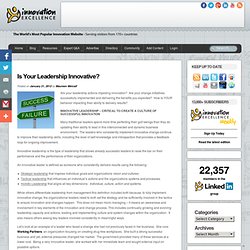
Are your change initiatives successfully implemented and delivering the benefits you expected? How is YOUR behavior impacting their ability to delivery results? Innovative Leadership – Critical to Create a Culture of Successful Innovation Many traditional leaders spend more time perfecting their golf swings than they do updating their ability to lead in this interconnected and dynamic business environment. The leaders who consistently implement innovative change continue to improve their leadership skills, including the level of self-knowledge and introspection that provides a feedback loop for ongoing improvement.
Innovative leadership is the type of leadership that allows already successful leaders to raise the bar on their performance and the performance of their organizations. An innovative leader is defined as someone who consistently delivers results using the following: How to Build An Innovation Leader. Every organization needs an Innovation champion.
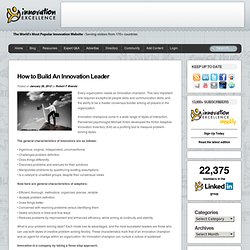
This very important role requires exceptional people skills and communication skills, and the ability to be a master consensus builder among all players in the organization. Innovation champions come in a wide range of styles of interaction. Renowned psychologist Michael Kirton developed the Kirton Adaptive Innovation Inventory (KAI) as a profiling tool to measure problem-solving styles. The general characteristics of innovators are as follows: Innovation Management Article Library. 25 Steps to Jump-Start your Innovation Journey. We’ve covered some essential ground to help you prepare your innovation journey, and now it’s time to put these concepts into action.

The innovation formula addresses the very specific tasks that have to be accomplished for innovation to emerge from your organization not only as a matter of luck or at random, but through a concentrated effort that results in sustained innovation performance. Here you will find the Taking Action steps along with 25 additional suggestions that we hope will help you to think and plan creatively and productively about how to make innovation a reality in your organization. Is it realistic to suggest that there’s actually a formula for innovation? Eight Essential Questions for Every Corporate Innovator. One of the first, and most lasting, pieces of career advice I received came from Linda Bush, my first project manager when I was a wee pup working at McKinsey & Company.

“Ask a lot of questions,” Linda advised me. “You might think you are being annoying, but it’s the only way you learn. And trust me, people will tell you when you have crossed the line.” There’s nothing quite like asking a good question. TOOLS FOR LEADERS: 5 Tables To Expand Your Thinking - The Ubiquitous Librarian. I have an assortment of tables, graphs, and charts that I have been collecting related to leadership and problem solving.
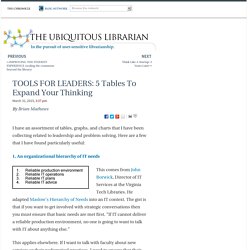
Here are a few that I have found particularly useful: 1. An organizational hierarchy of IT needs This comes from John Borwick, Director of IT Services at the Virginia Tech Libraries. He adapted Maslow’s Hierarchy of Needs into an IT context. This applies elsewhere. (Almost) Everything You Ever Wanted to Know About Creativity. 1Share Synopsis To be creative can be as simple as seeing something everyone else sees, but thinking what no one else thinks about it.
3 Paths Toward A More Creative Life. Everyone can learn to be more creative, but to become very creative, I’ve come to believe you need to lead a creative life.
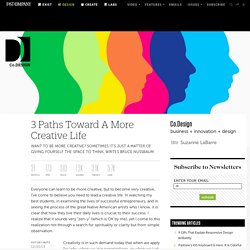
In watching my best students, in examining the lives of successful entrepreneurs, and in seeing the process of the great Native American artists who I know, it is clear that how they live their daily lives is crucial to their success. I realize that it sounds very “zen-y” (which is OK by me), yet I come to this realization not through a search for spirituality or clarity but from simple observation. Creativity is in such demand today that when we apply for jobs, when we join organizations, or when we just meet other people, we are asked to present our creative selves. But we can’t do that unless we understand the nature of our own creativity, locate the sources of our originality, and have a language that explains our work. If you are one of the growing number of “creatives,” or want to become one, you need to lead a creative life. 1. For good reason. 2. An Easy Way to Increase Creativity.
Creativity is commonly thought of as a personality trait that resides within the individual.

We count on creative people to produce the songs, movies, and books we love; to invent the new gadgets that can change our lives; and to discover the new scientific theories and philosophies that can change the way we view the world. Over the past several years, however, social psychologists have discovered that creativity is not only a characteristic of the individual, but may also change depending on the situation and context. The question, of course, is what those situations are: what makes us more creative at times and less creative at others?
One answer is psychological distance. According to the construal level theory (CLT) of psychological distance, anything that we do not experience as occurring now, here, and to ourselves falls into the “psychologically distant” category. Why Your Creativity Needs Boundaries to Thrive. The first few years after I decided to take my creative writing seriously, I couldn't overcome the nagging feeling that my fiction was simply a glorified hobby—like knitting or fishing.
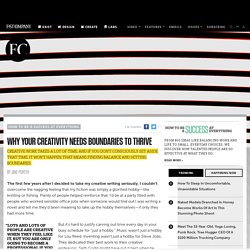
Plenty of people helped reinforce that. I'd be at a party filled with people who worked sensible office jobs when someone would find out I was writing a novel and tell me they'd been meaning to take up the hobby themselves—if only they had more time. But it's hard to justify carving out time every day in your busy schedule for "just a hobby.
" Music wasn't just a hobby for Lou Reed. Inventing wasn't just a hobby for Steve Jobs. Creative work is hard. Twelve Things You Were Not Taught in School About Creative Thinking. 2382 516Share Synopsis Aspects of creative thinking that are not usually taught. 1.
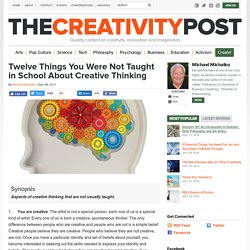
4 Things We Have Wrong About Creativity. “Creativity” may not be the first word that comes to mind when you hear the word “conglomerate.”

But Christian Stadil, CEO and co-owner of Denmark-based Thornico, a sprawling enterprise with holdings in food, technology, shipping, and others, will likely change your mind about that. Stadil is so enthusiastic about the concept of creativity that he has co-authored a new book with psychology professor Lenne Tanggaard, who teaches at the University of Aalborg in Denmark. In the Shower with Picasso, out in May, looks at creativity in business, the arts, and other areas and explores how we can all become more creative. In doing so, Stadil says the duo discovered that some of the very fundamental beliefs we have about creativity are wrong.
Here, he shares four common misconceptions. Creativity Myth #1: You should think outside the box. Most creative breakthroughs, including ideas and products, come from well-trod areas within your own expertise, Stadil says. Why We're More Creative When We're Tired and 9 Other Surprising Facts About How Our Brains Work. 12.6K Flares Filament.io 12.6K Flares × One of the things that surprises me time and time again is how we think our brains work and how they actually do. On many occasions I find myself convinced that there is a certain way to do things, only to find out that actually that’s the complete wrong way to think about it. For example, I always found it fairly understandable that we can multitask. Well, according to the latest research studies, it’s literally impossible for our brains to handle 2 tasks at the same time. Recently I came across more of these fascinating experiments and ideas that helped a ton to adjust my workflow towards how our brains actually work (instead of what I thought!).
So here are 10 of the most surprising things our brain does and what we can learn from it: 1. Study finds walking improves creativity. Stanford Report, April 24, 2014 Stanford researchers found that walking boosts creative inspiration. They examined creativity levels of people while they walked versus while they sat. A person's creative output increased by an average of 60 percent when walking. By May Wong L.A. What to eat to be creative. One might think that eating has nothing to do with your creative capacity, but he would be so wrong.
What you put in your system greatly influences how many good ideas you will have and how fast they will come. Most importantly you need to think long term. If you're in the creative business you have to come up with ideas daily or at least several times a week. You should not abuse your body for short term gains. On long term such practices will make you suffer. Numerous studies have shown that eating the right kind of stuff can increase your brain powers besides making you healthy. For fuel your brain uses carbohydrates. The fuel Carbohydrates are important because this is what your brain runs on. Creativity Support Tools : Report From a U.S. National Science . Creativity. Creativity is a phenomenon whereby something new and somehow valuable is formed, such as an idea, a scientific theory, an invention, a literary work, a painting, a musical composition, a joke, etc.
Scholarly interest in creativity involves many definitions and concepts pertaining to a number of disciplines: psychology, cognitive science, education, philosophy (particularly philosophy of science), technology, theology, sociology, linguistics, business studies, songwriting, and economics, covering the relations between creativity and general intelligence, mental and neurological processes, personality type and creative ability, creativity and mental health; the potential for fostering creativity through education and training, especially as augmented by technology; and the application of creative resources to improve the effectiveness of teaching and learning.
Definition[edit] Aspects[edit] Etymology[edit] History of the concept[edit] Where good ideas come from. 8 Secrets To Creative Thinking (Hint: Steal From Others) In the Fifties, I, together with just about every designer, was preoccupied with aesthetics and fashion. Design was the latest typeface in a modern layout looking like a Mondrian with lots of white space.
Is Your Leadership Innovative? Creativity is rejected: Teachers and bosses don’t value out-of-the-box thinking. Illustration by Rob Donnelly In the United States we are raised to appreciate the accomplishments of inventors and thinkers—creative people whose ideas have transformed our world. We celebrate the famously imaginative, the greatest artists and innovators from Van Gogh to Steve Jobs. Creativity at Work. Category:Creativity Techniques. Creativity techniques. Creativity techniques are methods that encourage creative actions, whether in the arts or sciences.
They focus on a variety of aspects of creativity, including techniques for idea generation and divergent thinking, methods of re-framing problems, changes in the affective environment and so on. Tools for creating ideas. CreatingMinds - tools, techniques, methods, quotes and quotations on all matters creative. Synectics. Synectics is based on a simple concept for problem solving and creative thinking - you need to generate ideas, and you need to evaluate ideas. Whilst this may be stating the obvious the methods used to perform these two tasks are extremely powerful. Preliminary planning In advance, hold a preliminary planning meeting with the problem owner(s). This checks that there are genuine problem owners, wanting new options that they themselves can implement, within their authority; helps you to understand the problem-owners' perceptions of the problem area; gives a feel for the number and quality of solutions needed; helps to ensure realistic expectations about results; and allows you to agree team membership.
Tackle Any Issue With a List of 100. The List of 100 is a powerful technique you can use to generate ideas, clarify your thoughts, uncover hidden problems or get solutions to any specific questions you’re interested in. Four Powerful Types of Creative Thinking. 36 Surprising Ways to Boost Creativity.
6 Powerful Tools for Generating Ideas. GoCreate.com. Thinking skills. There is no logic in connecting an office copier with 'nose'. 12 Practical Ways To Become More Creative. Ways to Increase Your Brain Power. 28. Creatine. Creative Problem Solving with SCAMPER. Critical and Creative Thinking - SCAMPERTechnique.
SCAMPER technique training for lateral thinking. SCAMPER Questions. Thinking like a genius: overview. WHERE GOOD IDEAS COME FROM by Steven Johnson. Random Word Generator (Plus) Creativity Portal® - Inspiring Creativity, Workplace Innovation, Artistic Expression, Creative Coaching. Creativity Web - Resources for Creativity and Innovation. The EUREKA! moment. 8 tips to make your life more surprising — from a “Surprisologist”
Vision Creation Worksheet. Free Online Idea Management and Collaboration Service. Creative Thought Processes. Innovation.